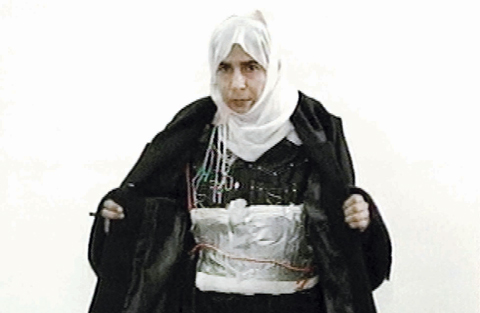 This file photo shows Iraqi Sajida Mubarek Atrous Al-Rishawi opening her jacket and showing an explosive belt as she confesses on Jordanian staterun television to her failed bid to set off an explosives belt inside one of the three Amman hotels targeted by Al-Qaeda in Jordan. —AP
This file photo shows Iraqi Sajida Mubarek Atrous Al-Rishawi opening her jacket and showing an explosive belt as she confesses on Jordanian staterun television to her failed bid to set off an explosives belt inside one of the three Amman hotels targeted by Al-Qaeda in Jordan. —APBEIRUT: The woman who blew herself up with an explosive vest in a suburban Paris apartment during a police operation Wednesday was far from the world's first female suicide bomber. While most suicide bombers are men, Islamic militant groups have occasionally deployed women to carry out such attacks. Long before the rise of Islamic radicalism, women suicide bombers were used by leftist and separatist groups in the Arab world and beyond. Here's a look at female suicide bombers over the years:
Lebanon and Palestinian Territories
During Israel's 18-year occupation of southern Lebanon that ended in 2000, several women belonging to leftist groups blew themselves up targeting Israeli forces. Among those women was Sanaa Mheidly, 17, who blew up a car rigged with explosives in an Israeli convoy in 1985, killing and wounding more than a dozen Israeli soldiers. She became the most prominent and the first to carry out such an attack in the Arab world. In the Palestinian territories, about a dozen women have carried out suicide attacks against Israelis since 2002 - including 27-year-old paramedic Wafa Idris, who blew herself up in downtown Jerusalem on Jan. 27, 2002. It was unclear if she planned to commit suicide. An 81-year-old Israeli man also died in that attack, the first by a Palestinian woman.
Al-Qaeda in Iraq
A decade ago, Al-Qaeda in Iraq leader Abu Musab Al-Zarqawi sent four members of his group - which would later morph into the Islamic State - to carry out bombings in his home country of Jordan. In that Nov, 9, 2005 assault, Sajida Al-Rishawi and her newlywed husband, Ali Al-Shamari, entered the ground-floor ballroom of Amman's Radisson SAS hotel while hundreds of people were celebrating a wedding reception. Al-Shamari set off his explosive belt among crowd. Al-Rishawi fled. Al-Zarqawi later claimed responsibility for the attack and mentioned a woman being involved, leading Jordanian officials to arrest al-Rishawi. Several days later, she appeared on Jordanian state television, opening a body-length overcoat to reveal two crude explosive belts. Al-Risawhi was executed earlier this year after IS burnt to death Jordanian pilot 1st Lt Muath Al-Kaseasbeh, whose warplane was shot down over Syria in December.
Turkey
Kurdish women have carried out several suicide attacks in Turkey since the 1980s, as have female members of leftist groups in their campaign against the government. The most recent attack occurred on Jan. 6, when a Turkish leftist group claimed responsibility for a suicide bombing at an Istanbul police station that killed an officer and wounded another. Authorities said the female bomber in that attack entered the building in the tourist district of Sultanahmet and blew herself up. In a statement posted online, the leftist Revolutionary People's Liberation Party-Front, or DHKP-C, said it carried out the attack. It called the bombing "an act of sacrifice."
Russia
Female suicide bombers from Chechnya and elsewhere in the North Caucasus were common enough that they became known as "black widows" in Russia. Many were the wives of or otherwise related to Islamic militants killed by government forces in their effort to suppress the separatist movement. Two of those female suicide bombers were to blame for the 2010 bombings of the Moscow metro, which killed some 40 people.
Nigeria
In Nigeria, a string of suicide bombings blamed on the militant group Boko Haram increasingly have been carried out by women and girls, some who are elderly and others as young as 10. Unlike many of the bombers used by IS in its Iraq and Syria, however, there are concerns that the Nigerian bombers are being deployed against their will. A military bomb disposal expert has told The Associated Press that many of the explosives in those blasts are remotely detonated, suggesting that the insurgents are strapping explosives to females they hold captive and sending them to their deaths.
Sri Lanka and India
Sri Lanka's Tamil Tiger rebels deployed multiple female suicide bombers as part of a more than two decade-long insurgency. Their bombing campaign against political, military and economic targets was aimed at creating an independent state for the ethnic minority Tamils. A Tamil woman blew herself up in 1991 in southern India, killing Indian Prime Minister Rajiv Ghandi.
Afghanistan
Female suicide bombers are very rare in Afghanistan, though one such attack was carried out by an elderly woman in Kunar province in 2010.
Islamic State group
IS proudly posts videos and photographs of fighters who carry out suicide attacks but they never posted any of women suicide attackers. Female fighters are active in the group, however, and have a brigade known as Khansaa. In 2010, Abu Omar Al-Baghdadi, who was then the leader of the Islamic State in Iraq group, said after a Shura Council meeting that women should not carry out suicide attacks. Current IS leader Abu Bakr Al-Baghdadi, who replaced the late commander, is believed to still abide by the rule. Mia Bloom, a professor of communications at Georgia State University and author of "Bombshell: Women and Terrorism," said that after a theological discussion, IS told women in October that they could blow themselves up if they are raided in their house. "She can detonate it without anyone's permission," she said.- AP









